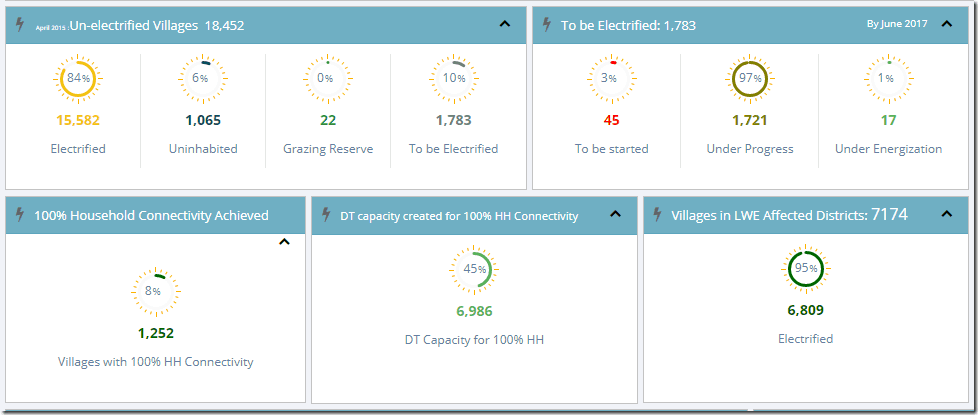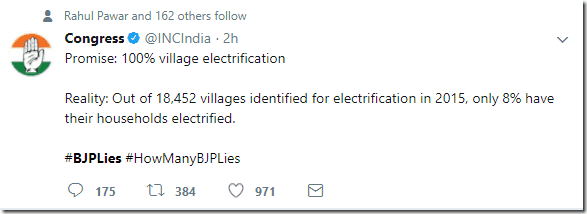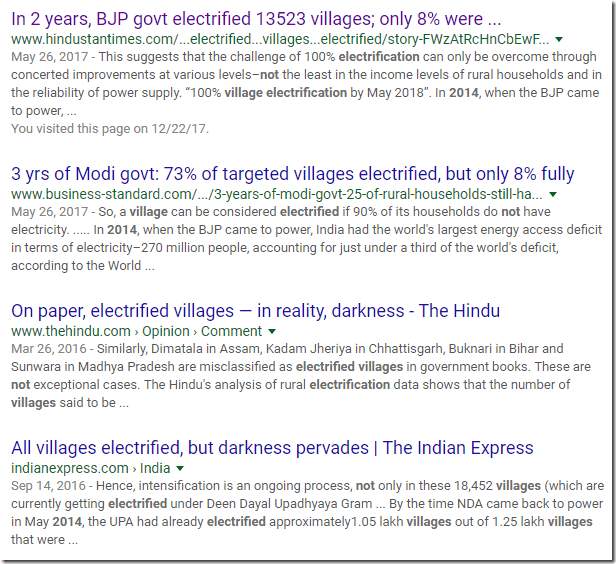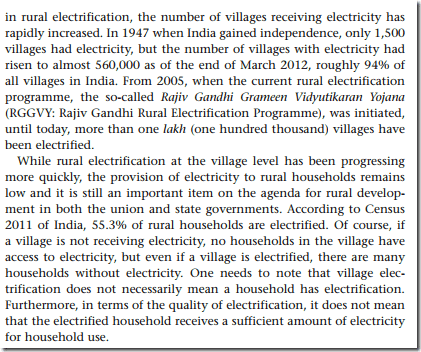Electrification Debate in India and Obfuscation of Facts
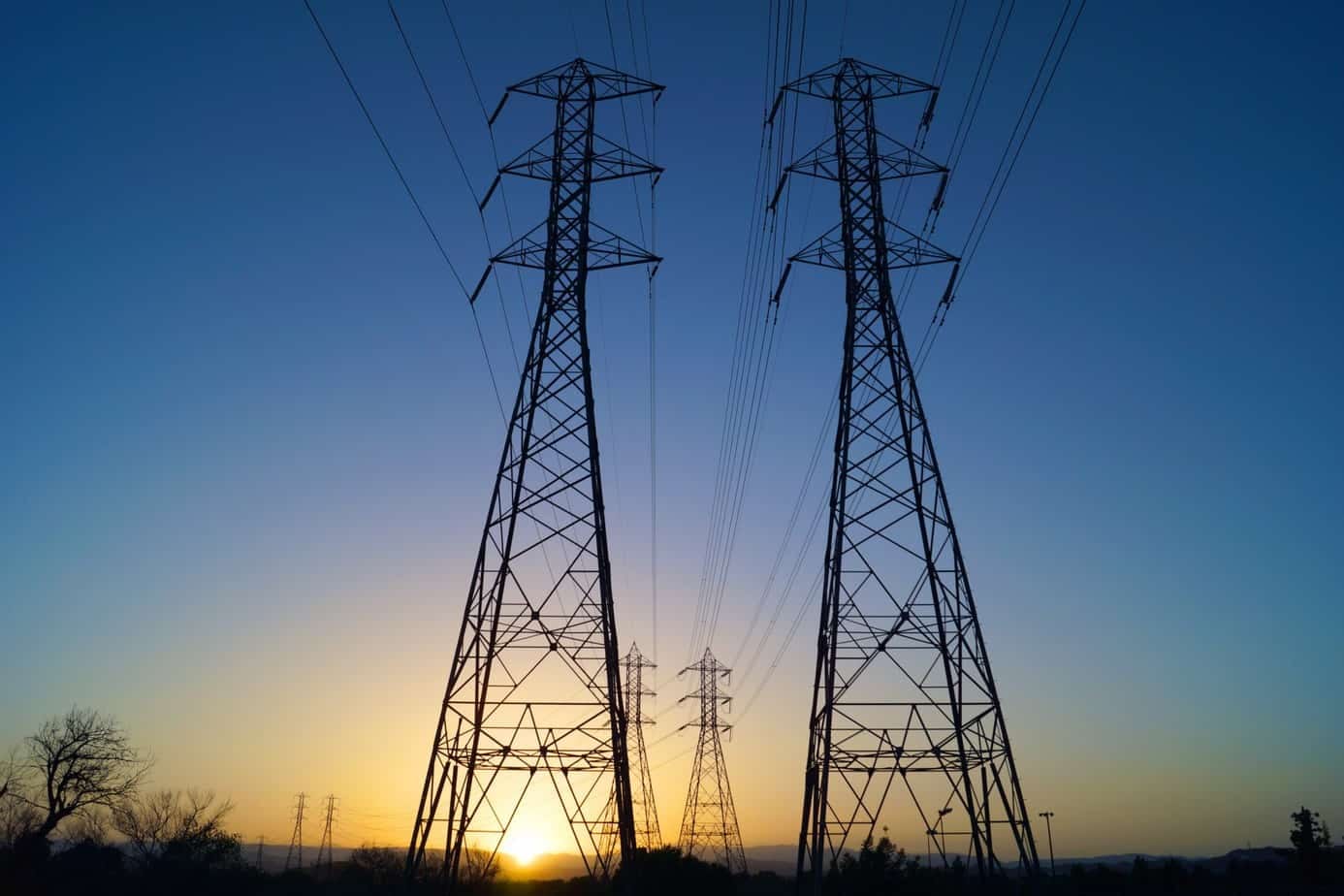
As of April 2015, the state of electrification in India was that 18,452 villages were still unelectrified. Which means there was no electricity link to that village. In just over two years, 84% of these unelectrified villages had electricity lines alongwith electricity at their doors. Infact only when 10% of the households of an village were provided electricity, could a village be declared as “Electrified”. However, not all the homes in these close to 16,000 villages could be electrified. Only 8% were.
The larger and broader rural electrification in India was undertaken as part of Deendayal Upadhyaya Gram Jyoti Yojana (DDUGJY). That was the goal of that program. However, it did NOT focus on electrification of the households. It could not. You see, first you need to create the infrastructure and bring the electricity to the village. Then, and only then, will it make sense to work on the household electrification.
So, as part of the second level of the whole electrification process, Pradhan Mantri Sahaj Bijli Har Ghar Yojana, also called Saubhagya Yojna – was launched in September 2017. Started with an outlay of Rs. 16, 320 crore, the goal for this program is to have 100% household electrification by December 2018. Government will work with those who don’t have electricity in their homes via the census. And government subsidies will be provided to them.
The beneficiaries for free electricity connections would be identified using Socio Economic and Caste Census (SECC) 2011 data. However, un-electrified households not covered under the SECC data would also be provided electricity connections under the scheme on payment of Rs. 500 which shall be recovered by DISCOMs in 10 instalments through electricity bill.
The solar power packs of 200 to 300 Wp with battery bank for un-electrified households located in remote and inaccessible areas, comprises of Five LED lights, One DC fan, One DC power plug. It also includes the Repair and Maintenance (R&M) for 5 years.
These are the facts. By 2012, 304 million Indians (24 percent of the population) did not have electricity! That was the situation. In 65 years where over 60 years were ruled by Congress, that was the state of the country! Let us get this one fact very clear.
Now, let us see what was done after that. In less than 3 years, the Modi Government brought electricity to all the remaining villages in the country which did not have electricity. By another year and a half – which is 4 years of rule – the target is to bring electricity to every household. Getting electricity to a village was the toughest thing. The subsequent work becomes easier.
The Game of Lies by Congress
This was the tweet sent out by Rahul Gandhi’s Congress party – which was responsible for 304 million people living without electricity for 68 years!!
And, taking a cue from Congress tweet, the entire media started writing about it.
The first article – completely misleading by placing statistics without context, originated in Hindustan Times, written by Mukta Patil of IndiaSpend, an organization which proposes to state statistics – but does so with an ideological agenda.
It talks about the difference in the number of villages which got electricity under Rajiv Gandhi Grameen Vidyutikaran Yojana (RGGVY) in the 8 years of the UPA rule and the number of vilages which got the electrified under the Deendayal Upadhyaya Gram Jyoti Yojana (DUGJY)
The previous Congress-led government, under the Rajiv Gandhi Grameen Vidyutikaran Yojana (RGGVY, a rural electrification scheme), had connected 108,280 villages to the grid between 2005-06 and 2013-14. From 2014 to 2017, under the BJP’s rural electrification drive, 14,528 villages have been electrified. On average, the United Progressive Alliance (UPA) government electrified 12,030 villages per year, while the BJP government has electrified 4,842–less than half the UPA’s average.
The numbers may be correct, but they mislead. For, even if 94% of the villages got electrified by March 2012, only 54% of the households had electricity (Source).
As Prakash Misra writes, one needs to fully comprehend what was done under the RGGVY.
The results are impressive, yet not so. As of March 2015, 96.7% of villages in India are electrified and moreover 15 states/UTs out of 36 have 100% electrification of villages. This data is of course misleading when seen in the light of the definition of what constitutes an ‘electrified village’. Apart from the infrastructure requirements, 10% of the village households need to be electrified for the officials to register it as a wholly electrified village. A village 10% electrified is as good as a village 100% electrified, since, on paper, it is already marked as a focus area completed. This clearly leaves a lot to be desired considering the objective of electrifying each household under the National Common Minimum Program, which the UPA itself brought about.
There was no data on how many of the households were given electricity under RGGVY.
Feeder Separation and Electrification
Now, even if there was data on that, there was a major issue. The reliability of the electricity connections to those households. Rural India is agricultural dominant area. The electricity provided for Agricultural use is different from that for household use. Which leads to burnt transformers due to high load and low power availability for households.
The survey revealed that in these six States, whatever be the official statistics on electricity access, on the ground the situation is quite shocking. On a scale of 0 to 100, the electricity index across the six States ranged from as low as 8.1 for Bihar to 41.8 for West Bengal. One particularly startling finding was that, among the households with the lowest level of access (or no access to electricity) around half actually had electricity connections, and therefore were officially classified as households with electricity.
The important issues here were the quality of the connection, the reliability of the power and the duration of the supply. It is possible for households with connections not to have received power supply for years, because a burnt transformer has not been fixed, or because the supply to the village or locality is so erratic that it does not amount to meaningful access.
Given all these issues and apparently the similar objectives and statistics from RGGVY and DUGJY, there are some major differences. How the electricity feed is structured. The difference in agricultural and household electricity had to be clearly demarcated and provided differently. Or else, it will all remain a useless exercise. While the DUGJY was about electrifying the 18452 villages, it was also about setting this basic anomaly from the UPA efforts of electrification under RGGVY correct! For all the villages!
Another major drawback with this definition is its tacit assumption that electricity in villages will only be used for household purposes or in public buildings. Most villages are in the rural areas and census defines a rural area as, among other things, a region having 75% or more of its population involved in agricultural activities. Electricity will obviously be required for agricultural activities to flourish and function seamlessly.
Given the distribution systems are installed without correctly estimating the usage requirements, when agricultural load is high, the electricity supply to households is reduced considerably. This leads to a complete dysfunction of the electric outreach system in rural areas. The distribution utilities resort to frequent load shedding in rural areas to mitigate the gap between supply and demand, which affects power supply to agricultural consumers as well as non-agricultural consumers owing to a common distribution network. Often the choice is between switching lights and fans in a classroom and running a tube well in the farm since they are linked on the same network.
Why is this different feeder information important? Because, it makes the most significant impact on the ground in rural communities. The world bank report titled Lighting Rural India: Experience of Rural Load Segregation Schemes in States states the benefits from the separation of the feeders in terms of the availability of power for the rural masses.
According to the survey, prior to feeder segregation, more than 80% consumers in both Gujarat and Rajasthan complained of low voltage problems, which came down to 6% post segregation; more than 80% domestic and over 50% agriculture consumers complained of frequent power outages, which reduced by less than half in both the states. Given the significant increase in the rural labor force involved in non-agriculture activities, increase in electricity supply has also led to several socio-economic benefits, including creation of jobs and improvement in the quality of life of the people in rural India.
While setting the anomaly of the feeder separation right, the DUGJY was followed by Saubhagya, which goes for Universal electrification. Remember, that RGGVY did NOT electrify 100% households. So, there is a huge target of households still not reaping the electricity benefits. This is how Saubhagya is different from and a necessary follow-up to the electrification programs done earlier.
First, both these schemes (RGGVY & DDUGJY) were/ are long-term projects to achieve rural electrification. Saubhagya is a short-term, target-oriented plan to light every Indian household by December 31, 2018. Therefore, Saubhagya is very different from both these schemes. It is not a repackaged RGGVY, nor does is it made redundant by DDUGJY.
Second, Saubhagya plans to electrify all Indian households, be they rural or urban. RGGVY and DDUGJY were/are schemes meant for rural electrification only. Although the new scheme seeks to provide electricity connections free of cost to beneficiaries who will be identified with the help of the 2011 Socio-Economic and Caste Census (SECC) data, other unelectrified households not covered by the SECC 2011 data would also be provided electricity connections – if they so desire — under the scheme on payment of Rs 500 only. That is why, Saubhagya is a scheme that targets, literally, universal electrification
Now, go back and look at the whole tweet and the media coverage. It attempts to show ONLY a part of the whole picture to ding the efforts to set the work on electrification on the right track and achieve real results by BJP.
Now, if you look back at the meeting in Mani Shankar Aiyar’s house, it becomes apparent that there is a concerted agenda to obfuscate facts by stating only parts of it while keeping the critical ones out to score a political point for Congress.
Featured Image: Power lines




